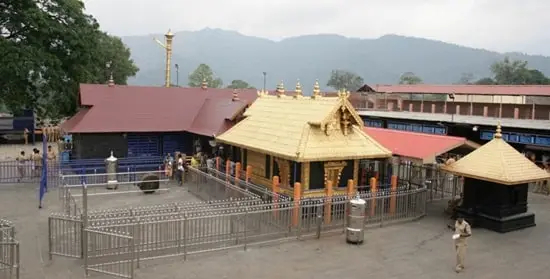Ayyappa Swamy happens to be one of the most well-known deities in Kerala. He is also known as Lord Ayyappan among his followers. In Tamil Nadu and Karnataka also, the deity has large number of devotees. Those who follow this deity, have to follow certain rules and regulations during the pilgrimage they take to the Sabarimala temple in Kerala. These rules are called as “Vratham,” and they are parts of the long tradition and culture related to the spiritual practices of the place. So here are the rules and regulations that you can go through if you are interested.
Lord Ayyappa Swamy Rules and Regulations:

According to Ayyappa Swamy, the pilgrimage to Sabarimala requires spiritual preparation. This preparation focuses on 41-day Vratham. At this time, devotees obey spiritual and customary rules.
1. Abstinence from Worldly Pleasures:
According to the Vratham, one must refrain from worldly pleasures and distractions. True believers must be disciplined. Avoid drinking, smoking, non-vegetarian cuisine, and sexual activity. The devotee’s austerity displays their spiritual dedication and submission to Lord Ayyappa.
2. Celibacy and Spiritual Practices:
Spiritual celibacy is stressed in the Vratham. Celibacy for 41 days symbolizes purity and detachment from earthly pleasures. In addition to chastity, followers pray, meditate, and contribute. These exercises foster inner peace, dedication, and spiritual growth, which are essential for the journey.
3. The Significance of Irumudi Kettu:
During the Vratham, devotees make a “Irumudi Kettu.” sacred bundle to travel. This bundle has two compartments representing pilgrimage traits.
The first compartment offers Lord Ayyappa ghee, coconut, rice, camphor, and incense sticks. These beautifully crafted and packaged presents demonstrate the devotee’s devotion to God.
The second compartment holds pilgrims’ clothes and supplies. Irumudi Kettu’s careful preparation shows the devotee’s love for the Lord and readiness for the tough journey.
4. Dress Code and Meaning
Sabarimala pilgrims must wear black or blue. This costume is noteworthy because Lord Ayyappa devotees revere these hues. It represents the pilgrim’s obedience to God and readiness to go spiritually without worldly distractions.
5. Austerities on the Path to Sabarimala:
The Lord Ayyappa pilgrimage to Sabarimala is a spiritual and physical journey. Sabarimala pilgrimage is as rigorous as spiritual preparation. It displays the pilgrims’ unwavering dedication to penance via physical suffering.
6. Navigating Dense Forests and Hilly Terrain:
The Western Ghats of Kerala are rich with woodlands and mountains on the way to Sabarimala. Small, winding pathways lead pilgrims through magnificent woods. The rough terrain has steep inclines and uneven routes. Due to faith and fortitude, pilgrims surmount these physical obstacles.
7. The Act of Walking Barefoot:
Barefoot pilgrimage to Sabarimala is unusual. Pilgrims remove their shoes to humble themselves and concentrate spiritually. Pilgrims do penance by walking barefoot on the difficult terrain for Lord Ayyappa.
8. Worldly Joy Abstinence:
Devotees forgo worldly pleasures throughout the pilgrimage. This Vratham asceticism continues till Sabarimala. Pilgrims avoid meat, alcohol, smoke, and sex. Their discipline and self-control represent spiritual surrender.
9. Silence and Austerity:
Silence and austerity are crucial to the journey. Reduce speech and mental noise to focus on Lord Ayyappa. Journey silence promotes concentration and introspection. Few goods are carried by pilgrims to show their detachedness.
10. Respect for Tradition and Rituals at Sabarimala:
To respect Sabarimala traditions, devotees must follow its conventions and practices while visiting. Temple spirituality depends on these centuries-old traditions.
11. Prescribed Path and Neyyabhishekam Ritual:
Devotees must follow the instructions to approach Lord Ayyappa’s sanctuary for Neyyabhishekam. This path represents the soul’s spiritual journey. Neyyabhishekam is a pilgrimage ritual. Ghee is offered to the deity to signify devotion and surrender.
12. Respect and manners:
Temple etiquette is crucial. Worshipping Lord Ayyappa requires humility and reverence. This etiquette applies to templegoers, priests, and the complex. Environment exudes reverence and commitment.
To increase their spiritual devotion, some devotees undergo Diksha before the Sabarimala trek, however it is not essential. A sacred Rudraksha seed necklace, or mala, enhances dedication. Diksha lifts pilgrims’ spirits and detaches them from worldly desires.
13. Strict access limits and ongoing debates:
Sabarimala has historically restricted entry for menstruating women (10-50 years old). Courts have questioned Lord Ayyappa’s celibacy-related restrictions. Society and law discuss it.
14. Strict Entry Restrictions and Ongoing Debates:
Although many Ayyappa devotees follow these ideals, not all do. Personal circumstances and devotion to these standards may impact Vratham and other pilgrimage activities. Passion for Lord Ayyappa drives the Sabarimala pilgrimage.
Conclusion
In a nutshell, all these rules and regulations that the devotees follow for Ayyappa Swamy demonstrates their lifelong devotion for the deity. It is also a symbol of showing respect to the age long tradition. With all these rules properly obeyed, the journey to Sabarimala temple turns out to be a spiritual awakening of the devotees, in achieving a mental bliss. This Experience is no doubt priceless as every moment of their lives.
Santosh Kumar is a Professional SEO and Blogger, With the help of this blog he is trying to share top 10 lists, facts, entertainment news from India and all around the world.
